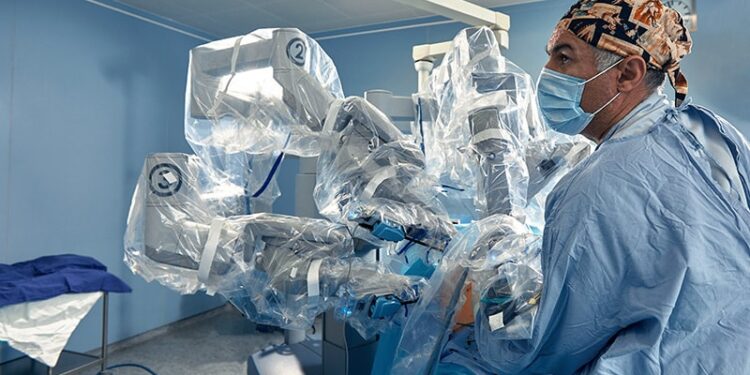A 30-day course of prophylactic antibiotics following robot-assisted radical cystectomy significantly reduces the incidence of urinary tract infections (UTIs) and related complications, researchers have found. However, experts urge caution in interpreting the findings due to methodological limitations of the study.
The researchers, led by Ahmed A. Hussein, MD, PhD, of Roswell Park Comprehensive Cancer Center in Buffalo, New York, randomized 77 patients undergoing robot-assisted radical cystectomy to receive either standard postoperative care or a 30-day course of oral antibiotics — either trimethoprim/sulfamethoxazole or nitrofurantoin — starting at discharge.

The primary endpoint was the occurrence of symptomatic UTIs within 90 days, defined by a positive urine culture (> 105 CFU/mL) and clinical symptoms such as fever or flank pain.
Dramatic Reduction in UTIs, Costs
None of the 37 patients in the antibiotic group developed a UTI within 90 days compared with 10 of 40 patients (25%) in the group who received standard care (P < .001). The antibiotic group also experienced significantly fewer infectious complications within 90 days of the procedure or discharge (14% vs 43%; P = .006) and readmissions related to infection (5% vs 30%; P = .007). The number needed to treat to prevent one UTI was calculated at 4 (95% CI, 2.5-7.0).
“This is very significant, as infectious complications are the most common after cystectomy and the main reason for readmission within 30 days of surgery. To bring this down from 25% to 0% improves patient care and saves a lot of resources for a procedure that is known for significant morbidity and for a very vulnerable patient population,” said Hussein, whose group published their findings in the Journal of Urology.
The approach led to significant savings. Hussein and his colleagues found the mean cost of care after the procedure fell by roughly $9000 in the antibiotic group (P =.007), with total 90-day costs more than $8000 lower (P = .022). This figure included expenditures associated with readmissions, any additional procedures, medications, and drains. No increase in adverse events or high-grade complications was observed in the antibiotic arm, the researchers reported.
Hussein said he believed the cost savings are generalizable to other institutions and health systems.
“Radical cystectomy is a highly morbid procedure with significant rate of complications regardless of open or robotic approach. Infections remain very significant,” he said. “While the choice of antibiotic may vary based on the local hospital antibiograms, we believe the approach — should be equally effective.
We encourage all centers considering this approach to review their retrospective data and to determine the most appropriate antibiotic for their patient population,” he added.
Editorial Perspective: Promising but Preliminary
Nicholas H. Chakiryan, MD, from the Department of Urology, Oregon Health & Science University in Portland, Oregon, noted the lack of placebo control and blinding in the study may have introduced bias. “If clinicians know a patient is on antibiotics, they may be less likely to diagnose a UTI,” he wrote in a commentary on the study.
In a separate commentary, Luigi Nocera, MD, from ASST Spedali Civili in Brescia, and Alessandro Viti, MD, from Università Vita-Salute San Raffaele in Milan, both in Italy, echoed these concerns and highlighted the gender imbalance between groups. More women, who are generally at higher risk for UTIs, were in the arm that received standard care (35% vs 14%; P = .036). They also pointed to the exclusion of patients with renal dysfunction and the absence of long-term data on antimicrobial resistance.
“Although extended antibiotic prophylaxis following [robotic cystectomy] appears to significantly reduce infectious morbidity and healthcare costs, its routine adoption requires caution,” Nocera and Viti wrote. “Future large-scale, blinded, placebo-controlled trials with proper stratification are essential to guide evidence-based clinical practice without undermining antibiotic stewardship principles.”
Methodological Rigor and Limitations
“The study employed a robust definition of UTI, requiring both microbiological and clinical criteria, which strengthens its validity compared to prior studies that included asymptomatic bacteriuria,” Nocera and Viti wrote.
All patients received intravenous ertapenem at anesthesia induction, and only 4% had ureteral stents. Compliance with the antibiotic regimen was high, with 68% of patients completing the full 30-day course.
“Before we designed the RCT [randomized controlled trial], we actually reviewed our retrospective data that were published in the Journal of Endourology,” Hussein said. “So this RCT was based on the sensitivities that our previous patient had, and therefore, we were expecting that these chosen antibiotics would work. There was really no significant difference among the two groups when it comes to adverse events.”
Despite its limitations, the trial provides the highest level of evidence to date supporting extended antibiotic prophylaxis after cystectomy. “This represents the highest quality data on the subject and is likely to change practice for many urologic oncologists, myself included,” Chakiryan wrote.
Still, widespread adoption should await confirmation from larger, multicenter, placebo-controlled trials, he added. “This study moves the needle,” he wrote, “but we’re not at the finish line yet.”
The sources cited in this story reported having no relevant financial conflicts of interest.
Jo Shorthouse is a London-based journalist with 17 years of editorial experience covering the healthcare industry for leading global publications.
Source link : https://www.medscape.com/viewarticle/prophylactic-antibiotics-after-robotic-cystectomy-slash-uti-2025a1000ijf?src=rss
Author :
Publish date : 2025-07-14 11:41:00
Copyright for syndicated content belongs to the linked Source.







